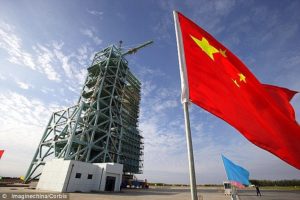by Jan Helge Mey L.LM. (McGill) and Dr. Ingo Baumann, BHO Legal, Germany

While the space activities of China continue to advance in breadth and depth, rather little is known about the legal and regulatory framework within the country. It is difficult to find online sources and most texts are only available in Chinese. The following short article tries to shed some light on the current legislative situation, with a special focus on those texts governing the growing commercial space sector. Links lead preferably to official and, if not available, to non-official English translations prepared for your courtesy.
Adherence to International Space Treaties
China is party to the majority of international legal instruments that form the corpus iuris spatialis, including:
- 1967 OST – Treaty on Principles Governing the Activities of States in the Exploration and Use of Outer Space, including the Moon and Other Celestial Bodies (Outer Space Treaty)
- 1968 ARRA – Agreement on the Rescue of Astronauts, the Return of Astronauts and the Return of Objects Launched into Outer Space (Rescue Agreement)
- 1972 LIAB – Convention on International Liability for Damage Caused by Space Objects (Liability Convention)
- 1975 REG – Convention on Registration of Objects Launched into Outer Space (Registration Convention)
- 1963 NTB – Treaty Banning Nuclear Weapon Tests in the Atmosphere, in Outer Space and under Water
- 1992 ITU – International Telecommunication Constitution and Convention
- 1971 ITSO – Agreement Relating to the International Telecommunications Satellite Organization (ITSO)
- 1976 IMSO – Convention on the International Mobile Satellite Organization (IMSO). (Source: UNOOSA, Status of International Agreements relating to Activities in Outer Space as at 1 January 2020, https://www.unoosa.org/documents/pdf/spacelaw/treatystatus/TreatiesStatus-2020E.pdf.)
Given the very recent achievements of the Chang’e mission 嫦娥工程and in view of the ambitious plans under the China Lunar Space Program 中国探月, it is noteworthy that China is not party to the Moon Agreement. However, the Moon Agreement has only gained 18 ratifications and 4 signatures so far, including only a handful of states involved in lunar activities.
Over the past years, China has also undertaken initiatives for the advancement of international space law. In 2014, China and Russia published the:
- 2014 Draft treaty on prevention of the placement of weapons in outer space and of the threat or use of force against outer space objects (PPWT) introduced by the Russian Federation and China
- English (official) http://daccess-ods.un.org/access.nsf/Get?OpenAgent&DS=CD/1985&Lang=E
and China frequently presents its view in disarmament affairs on transparency and confidence-building measures in outer space activities, summarized for instance in 2017:
- 2017 China’s View on Transparency and Confidence-Building Measures in Outer Space Activities
- Chinese
- 中国关于外空活动透明与建立信任措施的观点文件 https://www.un.org/disarmament/wp-content/uploads/2017/04/China-C-In-extenso.pdf
- English (official)
- Chinese
China is further engaged in the UN Committee on the Peaceful Uses of Outer Space (UNCOPUOS) and prepared, for example, a position paper about long-term sustainability of the outer space environment:
- 2016 China’s Position Paper on the Issues of Long-term Sustainability of Outer Space Activities
- Chinese
- English (official)
National Space Policy and Legislation
China´s State Council regularly updates the policy framework for China’s space activities. It publishes a white paper every five years, the next thus to be expected around the end of 2021.
- 2016 White Paper on China’s Space Activities
- Chinese
- English (official)
- http://english.www.gov.cn/archive/white_paper/2016/12/28/content_281475527159496.htm
The white paper defines the purposes, vision and principles of development, describes the major developments since 2011 and specifies the major tasks for the next five years, the policies and measures for development as well as the international exchanges and cooperation. The 2016 white paper acknowledges the ongoing efforts to adopt national space legislation:
5. Relevant legislative work strengthened
Efforts have been made to accelerate the formation of a legal system centering on the legislation of a national law to govern the space industry, including studying and formulating regulations on space data and their application management, the management of the export of astronautical products and technologies. The regulations in force on permits for space launch projects, registration of space-related items, and permits for scientific and technological research and production have been improved to guide and regulate various space-related activities in accordance with the law, which provides legal guarantee for building China’s space industry.
China has undertaken studies of international space law, and actively participated in the formulation of international rules regarding outer space.
China has not yet adopted a comprehensive national space law, even if works are ongoing since several years. As of today, the national legislative and regulatory framework consists of mostly lower-level, separate administrative measures for selected regulatory areas. International sources on the framework are incomplete and outdated. The United Nations Office for Outer Space Affairs (UNOOSA) National Space Law Collection provides only a broken link to an English version of the White Paper on China´s Space Activities published in 2003. (Source: UNOOSA, online via https://www.unoosa.org/oosa/en/ourwork/spacelaw/nationalspacelaw/index.html.) This is rather surprising, as the two most relevant pieces of national legislation were already adopted shortly ahead of this White Paper, namely:
- 2001 Administrative Measures for the Registration of Objects Launched into Outer Space
- Chinese
- English
- Courtesy English translation by BHO Legal:
- https://www.bho-legal.com/wp-content/uploads/2021/02/2001-Measures-Registration-CN-EN-courtesy-translation.pdf
- 2002 Interim Measures for the Administration of Licenses for Civil Space Launch Projects
- Chinese
- 民用航天发射项目许可证管理暂行办法
- http://www.moj.gov.cn/Department/content/2003-03/21/594_205556.html
- English
- Courtesy English translation by BHO Legal:
- https://www.bho-legal.com/wp-content/uploads/2021/02/2002-Interim-Measures-Licensing-Civil-Space-Launch-Project-CN-EN-courtesy-translation.pdf
- Chinese
Other and more recent regulations include the:
- 2010 Administrative Measures for Space Debris Mitigation and Spacecraft Protection
- Chinese: 空间碎片减缓与防护管理办法
- Albeit being frequently referenced in official documents, the measures are apparently classified and not publicly available (The document request at a university is referred to the office for classified documents, online via http://kjc.hrbeu.edu.cn/2020/0914/c11318a255103/page.htm. )
- 2010 Civilian Space Research Project Management Interim Measures
- Chinese: 民用航天科研项目管理暂行办法 (科工一司〔2010〕828)
- 2012 Civilian Space Technology Advance Research Project Management Implementation Rules
- Chinese: 民用航天技术预先研究项目管理实施细则 (科工一司〔2012〕361号)
http://www.cnsa.gov.cn/n6758823/n6758839/c6802366/content.html
- Chinese: 民用航天技术预先研究项目管理实施细则 (科工一司〔2012〕361号)
- 2012 Notice on the Implementation Rules for the Management of Civil Aerospace Research Project:
- Chinese: 民用航天科研工程管理实施细则 http://www.sastind.gov.cn/n157/c6802361/content.html
- 2013 Civilian space launch project license application form
- Chinese: 民用航天发射项目许可证申请书 http://www.sastind.gov.cn/n4245/c61423/content.html
- 2016 Interim measures for the management of civilian satellite projects
- 2019 Circular on Promoting the Standardised and Orderly Development of Commercial Launch Vehicles
- Chinese
- 国家国防科技工业局、中央军委装备发展部关于促进商业运载火箭规范有序发展的通知 (科工一司〔2019〕647号)
- http://www.sastind.gov.cn/n112/n117/c6806483/content.html
- http://www.gov.cn/zhengce/zhengceku/2020-03/24/content_5494956.htm
- English (official)
- Courtesy English translation by BHO Legal:
- https://www.bho-legal.com/wp-content/uploads/2021/02/2019-Development-of-Commercial-Launch-Vehicles-CN-EN-courtesy-translation.pdf
- Chinese
The latter document provides an interesting reference list of relevant laws, regulations and other documents related to space activities in China. These include:
I. The National Security Law of the People’s Republic of China
2015 National Security Law
Chinese: 中华人民共和国国家安全
http://www.moj.gov.cn/organization/content/2015-07/27/jlzxxwdt_7256.html
Article 32 reads: “The State insists on the peaceful exploration and use of outer space, the international seabed area and the polar regions, enhances the capacity for safe access, scientific research, development and utilization, strengthens international cooperation, safeguards the security of China’s activities, assets and other interests in outer space, the international seabed area and the polar regions.”
II. The Work Safety Law of the People’s Republic of China
III. Regulations of the People’s Republic of China on the Administration of Exports of Military Products
IV. Regulations of the People’s Republic of China on Export Control of Missiles and Missile-Related Items and Technologies
V. Regulations of the People’s Republic of China on the Administration of Import and Export of Technology
VI. Opinions of the State Council on Opening Up Major National Scientific Research Infrastructures and Large-scale Scientific Research Instruments to the Public
VII. Opinions of the General Office of the State Council on Promoting the Development of a deep Military-Civilian Integration in the fields of Defence Science and Industry
VIII. Regulations on the Safety Management of Dangerous Chemicals
IX. Regulations on the Safety Management of Civilian Explosive Substances
X. Regulations on the Administration of Scientific Research and Production Licenses for Weapons and Equipment
XI. Measures for the Implementation of Scientific Research and Production Licenses for Weapons and Equipment
XII. Regulations on the Registration of the Business Scope of Enterprises
XIII. Interim Measures for the Administration of Licenses for Civil Space Launch Projects
XIV. Interim Measures on the Safety Management of Military-Industrial Dangerous Chemicals
XV. Circular of the State Administration of Science Technology and Industry for National Defence and the Ministry of Finance on Promoting the Opening Up of Major Military-Industrial Experimental Facilities and Large-scale Scientific Research Instruments to the Public
XVI. Administrative Measures for Space Debris Mitigation and Spacecraft Protection
XVII. International space regulations
XVIII. Liability Convention
Apart from this list, the recently revised National Defence Law is a relevant source of information for military space activities:
- 2020 National Defence Law (adopted in 1997, revised on 26 December 2020)
- Chinese: 中华人民共和国国防法
http://www.moj.gov.cn/Department/content/2020-12/26/592_3262804.html - Article 30 reads: „The territorial land, territorial waters and airspace of the People’s Republic of China is sacrosanct. The State builds a strong and solid modern border defence, sea defence and air defence, take effective defence and management measures to defend the security of the territorial land, territorial waters and airspace, and safeguard the national maritime rights and interests.
The State takes the necessary measures to safeguard the security of its activities, assets and other interests in other major security areas such as space, electromagnetics and cyberspace.”
- Chinese: 中华人民共和国国防法
Very recently on 17 January 2021, the China National Space Administration adopted rules for the management of lunar samples from its Chang’e Lunar Space Programs, thereby also setting the framework for international cooperation in scientific research of the Moon:
- 2021 Notice of the China National Space Administration on regulations on lunar sample management
- Chinese
- 国家航天局关于印发《月球样品管理办法》的通
- http://www.cnsa.gov.cn/n6758823/n6758838/c6811123/content.html
- English (official)
- Chinese
It is apparent from this brief overview that China currently does not have a comprehensive and unified space law in place. However, the above list of documents with relevance to space law and policy in China – which does not pretend to be exhaustive – shows that the legal and regulatory framework for space activities also advances in breadth and depth. There seems to be a varying degree of transparency: requirements for space debris mitigation, for example, are apparently not publicly available, whereas the documents with respect to fields in which international cooperation is welcome, such as the use of lunar samples, are widely disseminated, including in official English translations.
A reliable and transparent legal and regulatory framework is an important element for creating a thriving commercial space economy. So far, the publicly available regulations appear to be rather high-level with respect to detail and mostly low-level with respect to legal hierarchy. It is difficult to assess to what degree China offers a beneficial environment for the fast-growing commercial space activities. For example, while companies have to take out insurance, there is apparently no clear indication on required insurance sums or applicable liability caps. Very little is known regarding practical experiences with licensing processes in terms of duration, fees, and individual conditions. When the new commercial launch service companies will attempt to enter the international market, foreign customers will require a certain level of transparency and might require copies of authorizations and licenses under their respective national licensing frameworks.
Given the impressive advances in space activities, the UNOOSA National Space Law Collection certainly deserves an update on China.
Contact us at: j[email protected] and [email protected] or follow us at www.bho-legal.com or LinkedIn
Jan Helge Mey and Dr. Ingo Baumann are both partners of BHO Legal, one of the leading European space law firms and a regular contributor to SpaceWatchGlobal. Jan Helge Mey studied in Cologne (Germany) and Qingdao (PR China) and specialized in air and space law at McGill University in Montréal (Canada). He worked at the Institute of Air and Space Law in Cologne, as legal trainee at the German Aerospace Center, and as lawyer at a global law firm where he became a certified lawyer for public procurement law. Dr. Ingo Baumann wrote his doctoral thesis at the Cologne Institute of Air and Space Law, then worked as in-house lawyer in German Aerospace Centre DLR e.V. and later as CEO of the DLR GfR mbH until end of 2008. Since beginning of 2009, he is founding partner of BHO Legal and a prominent contributor to space law, among others with his column “GNSS & the Law” in InsideGNSS or as co-editor of the “Contracting for space – contract practice in the European Space sector” book and conference project.
 SpaceWatch.Global An independent perspective on space
SpaceWatch.Global An independent perspective on space




